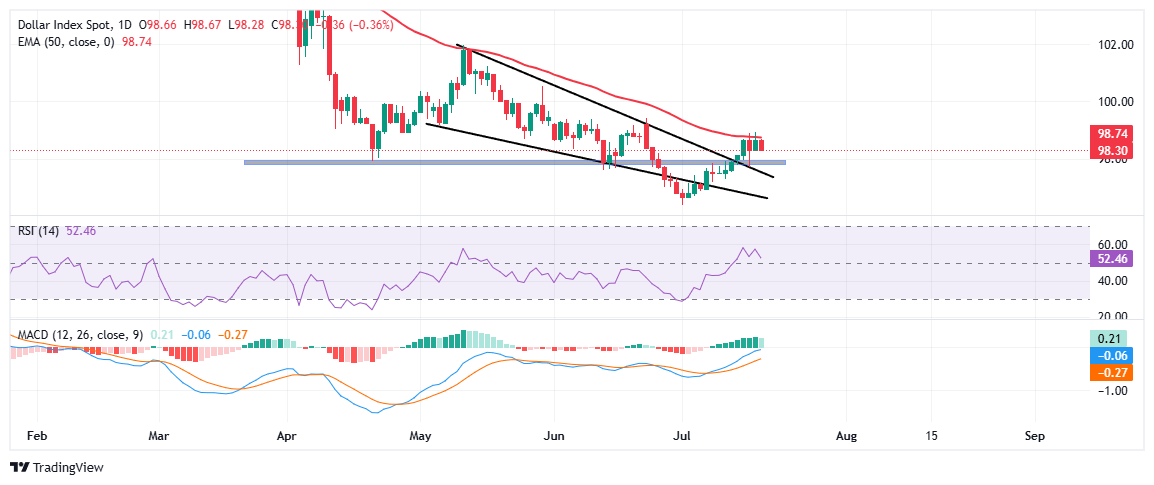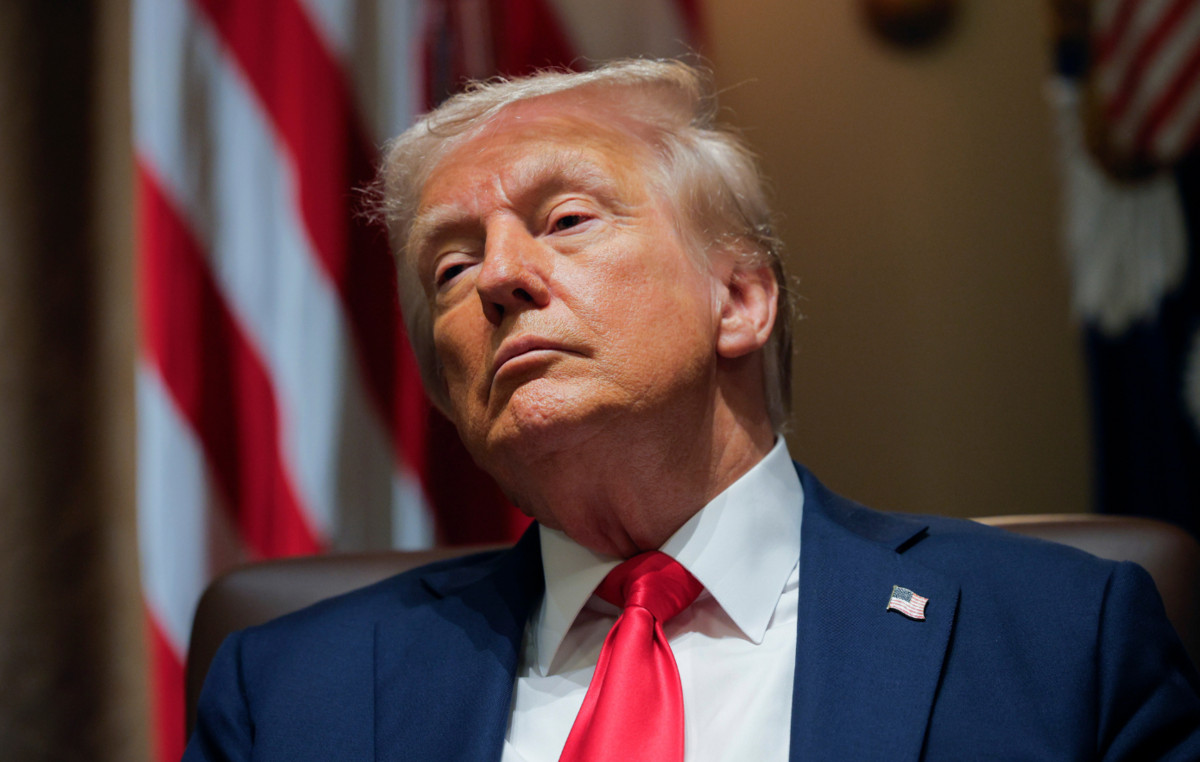- The US dollar is going back on Friday despite the solid internal data and signs of a resistant labor market.
- The yields of the US Treasury bonds fall from the recent maximums, amplifying the pressure on the US dollar.
- The technical configuration in the DXY indicates a decreasing impulse below the EMA of 50 days after a rupture of a descending wedge pattern.
The US dollar (USD) is losing strength on Friday, going back from the maximum three weeks as the impulse cools. Even so, the US dollar is still supported by the robust economic data of the US published this week, which has reduced the probability of immediate cuts in interest rates by the Federal Reserve (Fed).
The US dollar index (DXY), which follows the value of the dollar against a basket of six main currencies, is down around 0.40%, around 98.23 in the Friday’s negotiation session. The setback occurs after the index touched a maximum of three weeks on Thursday, briefly approaching the 99.00 mark.
The data on the feeling of the consumer, published earlier today, added another layer to this week’s economic resilience. The strongest figure than expected reinforced the notion that American homes remain cautiously optimistic, despite persistent inflation. While optimistic data supports the patient posture of the Fed on rates cuts, they were not enough to reverse the intradication of the US dollar, since the operators continue to digest the broadest risks around the yields, tariffs and independence of the central banks.
The preliminary feeling of the consumer of the University of Michigan for July rose to 61.8 from 60.7 in June, exceeding 61.5 expectations. Both current conditions and expectations components improved, reflecting a cautious optimism among American homes.
Retail sales and initial requests of unemployment They indicated a robust consumer demand and a continuous strength in the labor market. Meanwhile, the manufacturing index of the Fed Filadelfia surprised upwards, shooting at 15.9 in July from -4.0 in June and challenging the expectations of a negative reading. In the front of inflation, both the consumer price index (CPI) and the production price index (IPP) indicated persistent price pressures, reminding markets that inflation is not yet completely controlled.
These numbers arrive in a context of commercial frictions derived from the commercial policy of President Trump, increasing the chances of the Fed maintaining the stable interest rates for longer.
Market movements: falling background, increasing commercial tensions and divergent opinions of the Fed
- The 10 -year Treasury bonus yield from the US fell to 4.44% on Friday, going back from a maximum of five weeks of 4.50% earlier. The fall in yields reinforces the downward pressure over the US dollar.
- The US Department of Commerce imposed preliminary anti -dumping rights of 93.5% on Chinese graphite imports after determining that the products were unfairly subsidized, Bloomberg News reported. The decision follows a December request from the producers of US active anode materials, which accused Chinese companies of violating anti -dumping laws. With existing tariffs already in force, the total effective rights is now 160%, according to the group. This marks a significant escalation in commercial tensions between the US and China, especially in critical sectors such as clean energy and electric vehicles. The measure could also trigger retaliation from Beijing, adding another layer of uncertainty to the broader commercial perspective.
- The nerves of the market were altered this week amid rumors that President Trump could say goodbye to the president of the Fed, Jerome Powell. The tensions calmed down after Trump went back to the threat, describing it as “very unlikely” to fire Powell. Even so, the headlines revived concerns about political interference in monetary policy. The US dollar recovered as the immediate risk vanished, but the uncertainty about the independence of the Fed continues to cloud the prospect for the US dollar.
- Together with his criticism of the president of the FED, Jerome Powell, President Trump has publicly pressed to the Federal Reserve, asking for lower interest rates. Arguing that current indebtedness costs are too restrictive to consumers and companies, Trump has blamed the Fed to “stop the economy” and warned that inaction could undermine US competitiveness I could incline the trajectory of monetary policy in the coming months.
- On Thursday night, the governor of the FED, Christopher Waller, a main candidate to happen to Powell, renewed his call to a 25 basic points cut at the July meeting. Waller minimized inflation driven by tariffs as a unique “shock” price, arguing that it does not justify maintaining the restrictive policy. He emphasized that monetary policy should be closer to being neutral, non -restrictive, and pointed out the growing risks in the labor market, observing that the growth of employment in the private sector is close to a slowdown. In contrast, the president of the Fed in New York, John Williams, warned Wednesday that tariff -related inflation is just beginning to feed on the economy and could persist until 2026. Although both emphasized the importance of the independence of the Fed, their divergent opinions about the moment of politics added uncertainty to the market over the next movement of the Fed.
- The last points chart shows that the Fed expects to reduce the reference rate to around 3.9% by the end of this year from the current range of 4.25-4.50%. This implies two cuts of 25 basic points in the second half of the year.
Technical analysis: DXY recovery stops below the 50 -day EMA

The American dollar index (DXY) faced a strong rejection near the psychological level of 99.00 after breaking a descending wedge pattern earlier this week. The price drilled above the higher trend line of the wedge, but the bullish impulse has stagnated just below the 50 -day EMA in 98.74, which is acting as a key resistance.
A daily closure confirmed above this level could open the door towards 99.50-100.00, while immediate support is near 97.80-98.00, an old resistance zone that can now serve as a floor.
Impulse indicators reflect a cautionly bullish inclination. The relative force index (RSI) in the daily chart remains above the midpoint in around 53, noting that buyers are still in control, although without a strong conviction.
The indicator of convergence/divergence of mobile socks (MACD) remains positive, with the MacD line still above the signal line, reinforcing the upward inclination. However, both indicators show signs of a decreasing impulse, suggesting a period of consolidation or a possible setback before the next decisive movement.
Fed – Frequently Questions
The monetary policy of the United States is directed by the Federal Reserve (FED). The Fed has two mandates: to achieve prices stability and promote full employment. Its main tool to achieve these objectives is to adjust interest rates. When prices rise too quickly and inflation exceeds the objective of 2% set by the Federal Reserve, it rises interest rates, increasing the costs of loans throughout the economy. This translates into a strengthening of the US dollar (USD), since it makes the United States a more attractive place for international investors to place their money. When inflation falls below 2% or the unemployment rate is too high, the Federal Reserve can lower interest rates to foster indebtedness, which weighs on the green ticket.
The Federal Reserve (FED) celebrates eight meetings per year, in which the Federal Open Market Committee (FOMC) evaluates the economic situation and makes monetary policy decisions. The FOMC is made up of twelve officials of the Federal Reserve: the seven members of the Council of Governors, the president of the Bank of the Federal Reserve of New York and four of the eleven presidents of the regional banks of the Reserve, who exercise their positions for a year in a rotary form.
In extreme situations, the Federal Reserve can resort to a policy called Quantitative Easing (QE). The QE is the process by which the Fed substantially increases the flow of credit in a stuck financial system. It is a non -standard policy measure used during crises or when inflation is extremely low. It was the weapon chosen by the Fed during the great financial crisis of 2008. It is that the Fed prints more dollars and uses them to buy high quality bonds of financial institutions. The one usually weakens the US dollar.
The quantitative hardening (QT) is the inverse process to the QE, for which the Federal Reserve stops buying bonds from financial institutions and does not reinvote the capital of the bonds that it has in portfolio that they expire, to buy new bonds. It is usually positive for the value of the US dollar.
Source: Fx Street
I am Joshua Winder, a senior-level journalist and editor at World Stock Market. I specialize in covering news related to the stock market and economic trends. With more than 8 years of experience in this field, I have become an expert in financial reporting.







